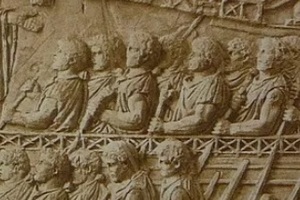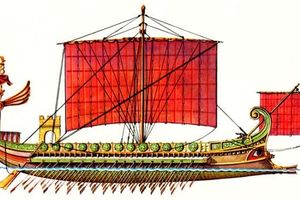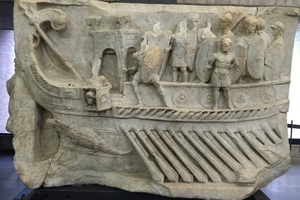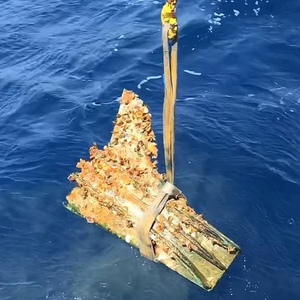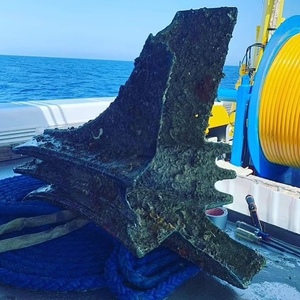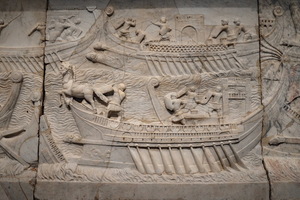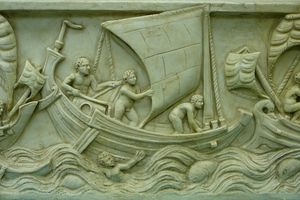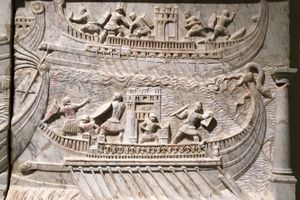Ancient Roman Naval Fleet
Different ships can vary significantly in their characteristics. Some are heavy and unwieldy, while others are small, fast, and maneuverable. However, in order to achieve victory in naval battles, often a single type of ship was simply not enough. For example, a monoreme would be faster and more maneuverable than a quinquereme, but it would greatly lack in combat power because ramming - the rostrum - was the main naval weapon of antiquity. Now let's talk about the various types of warships in the ancient Roman fleet.
Classification of Roman warships
The classification of ancient Roman warships often derived from the Latin numeral denoting the number of rows of oars. For example, the unireme (Latin: uniremis) had one row of oars, the bireme (Latin: biremis) had two, the trireme (Latin: triremis) had three, the quadrireme had four rows, the quinquereme and hexareme had five and six rows of oars, respectively. This is reported by the ancient Roman author Isidore (Isid., Orig., XIX, 23). However, biremes were often referred to as Liburnians, referring to the pirate past of the ship.
Light and medium ships
Unireme (Latin: Uniremis) - a light wooden vessel with one row of oars and no deck. Sometimes it is also referred to by its Greek name, Monoreme (Monera). Unireme was the smallest type of vessel used for military purposes. In some exceptional cases, the Roman fleet resorted to requisitioning merchant ships, where uniremes were more common. Penteconter - a type of warship similar to uniremes but larger in size. Mention of this type of ship, along with triremes, can be found in Herodotus' description of the Battle of Salamis (Herod., VIII, 48). These ships often housed small boarding parties.
Bireme, or Liburnian. Bireme (Latin: Biremis) - a ship with two rows of oars (Isid., Orig., XIX, 23). According to Greek classification, it was called Diera. Liburnian is the name of a ship that was structurally similar to a bireme. The name originated from the Liburnian pirates, who used such ships for maritime raids, as mentioned by Appian (App., Illyr., I, 3). Over time, the term "Liburnian" also came to refer to biremes because these ships were very similar. There was a mast in the middle of the ship. The absence of a ram (rostrum) was due to the ship's pirate past: pirates, unlike military vessels, did not sink ships but boarded them. Therefore, they simply did not need a ram, and its presence significantly reduced the speed of the ship. The length of a Liburnian varied from 24 to 30 meters. The exact number of crew members is unknown.
Trireme (Latin: triremis). Without exaggeration, the trireme was the most common warship of antiquity. Despite its size, it possessed impressive combat power. The main weapon of the ship was the ram - the rostrum - located in the bow. However, on some reliefs, triremes can be seen with superstructures on which various types of projectile machines were placed. During the Republican era, these class of ships were equipped with "Corvus" (Latin: corvus) - boarding bridges with beaks at the end.
The exact dimensions of the ship are not known for certain. However, there is a popular hypothesis that the length of the ship's hull did not exceed 42 meters, and the width was 8 meters. The ship was also equipped with two masts. The central mast was vertical and located approximately in the middle. The second mast was inclined and located at the bow (in modern maritime terminology, it is called a bowsprit). Under sail, a trireme could reach speeds of up to 8 knots (approximately 14.8 km/h). When rowing, this speed would be reduced to 5 knots (almost 10 km/h). Before battle, the central mast was removed.
Heavy ships (larger than triremes)
Studying ships larger than triremes poses a challenge. Ancient authors, when describing warships, often did not deem it necessary to delve into details that were well-known to their contemporaries. The main criterion for distinguishing ships for ancient authors was the number of rows of oars on the ship, rather than the number of rowers on a single oar. The classification of warships according to Isidore appears as follows: "Biremes are ships with a paired row of oars, triremes and quadriremes have three and four rows respectively. Both pentaremes and hexaremes have five and six rows" (Isid., Orig., XIX, 23). Vegetius also affirms that the size of ships depended on the number of rows of oars (remorum ordines) they had (Veg., VI, 37).
Related topics
History of the Republican Fleet of ancient Rome, Trireme,

 Gallery
Gallery






